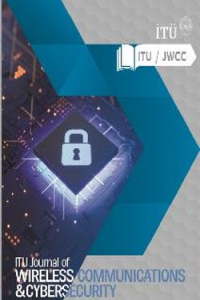Aim & Scope
ITU Journal of Wireless Communications and Cybersecurity aims to publish high-quality research and review articles in mobile communications and cybersecurity.
The scope of the journal includes the topics listed below but not limited to
Wireless Communications
• Artificial Intelligence for Communications
• Beyond 5G and 6G Wireless Communications
• Communication Protocol Design and Analysis
• Device-to-device, Cooperative Communications, and Relay-aided Communications
• Green, Energy Harvesting Communication, and Ambient Backscattering Systems
• IoT Communications
• Integrated Sensing and Communications
• MAC, Routing, and Congestion Control
• MIMO and Massive MIMO Systems
• Nano- and Molecular Communications
• Physical Layer Security, Information- and Communication-theoretic Aspects of Security
• Quantum Communications
• Optical Communications
• Reconfigurable Surfaces and Intelligent Surfaces
• Non-Terrestrial Communication
Cybersecurity
• Access control and authorization
• Authentication and Biometrics
• Blockchain technologies and Cryptocurrencies
• Cloud security and IoT security
• Cryptography and cryptanalysis
• Hardware security
• Human factors in cybersecurity
• Machine learning and cybersecurity
• Malware and unwanted software
• Network security
• Privacy-enhancing technologies, anonymity, and censorship
• Web security
• Wireless and mobile security/privacy
Author Guidelines
It is requested to submit an article to the journal;
- Download and use Latex template file published on the website and submit article to journal as a pdf file,
- Follow the instructions in the template file,
- Create the bibliography in IEEE style.
Due to the double-blind confidentiality policy, there should be no author information and support / acknowledgment sections in the study. This information will be added after the acceptance of the article.
As a result of the analysis of the article with iThenticate or other plagiarism programmes, the total similarity in the manuscript should be below 20%.
Please download the copyright transfer form here: <link>
Ethical Principles and Publication Policy
1. Author(s) must take ethics committee approval, and this approval must be specified in the manuscript they submit for:
- All kinds of research carried out with qualitative or quantitative approaches that require data collection from the participants by using survey, interview, focus group work, observation, experiment, interview techniques,
- Use of humans and animals (including material/data) for experimental or other scientific purposes,
- Clinical studies on humans,
- Animal studies,
- Retrospective studies in accordance with the personal data protection law
Author(s) should state the ethics committee approval information (committee name, date, number, etc.) in the ‘’Method’’ section of the manuscript and also on the first/last page.
During the submission of the article, in addition to the text of the manuscript, the Ethics Committee Approval report should be uploaded to the system.
In addition, in case reports, it is necessary to include information that the informed consent form was signed in the article.
2. The article should specify whether legal/special permission is required. If the study covers the application made in an institution, it should be clearly stated on what date and with which decision or permission number was obtained from the relevant institution.
3. Permission must be obtained from the owners for the use of scales, surveys and photographs belonging to others, and this must be stated in the article (with reference).
4. As a result of the analysis of the article with iThenticate or other plagiarism programmes, the total similarity in the manuscript should be below 30%.
5. The Author, Reviewer and Editor must comply with the ethical rules.
Authors: Only people who contributed to the relevant study should be considered as authors. Conflict of interest must be declared at the end of the article.
Reviewers: Reviewers should consult the Editor regarding the review process if they have any suspicion about conflict of interest.
Editors: Editor-in-Chief, Assoc. Editor-in-Chief or Field Editor appoints at least 2 people to evaluate the manuscript as referees. The names of the referees who evaluated the manuscript are not notified to the authors. Editor-in-Chief, Assoc. Editor-in-Chief or Field Editor is responsible for managing the peer-review process of the manuscript and they have the right to reject the relevant manuscript in case of any conflict of interest.
6. They are deemed to have accepted and declared that the submitted manuscripts comply with the Research and Publication Ethics.
7. Scientific articles submitted to journals should take into account the International Standards for Editors and Authors of COPE (Committee on Publication Ethics).
8. It is necessary to comply with the copyright regulations for the intellectual and artistic works used.
9. A statement of “Support” or “Acknowledgements” and “Conflict of Interest” must be given at the end of the article.
In the "Support" or "Acknowledgement" part, if the study was supported by an institution or BAP, the support should be indicated with the project number.
In addition, it can be thanked if there is someone who was not included in the article as author and supported the data collection etc. of the research.
To clarify the issue of conflict of interest, Author(s) should declare at the end of the article whether there is any “Conflict of Interest”
Price Policy
.

